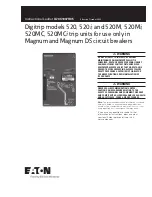
12
Instructional Leaflet
IL70C1037H05
Effective October 2009
Digitrip models 520, 520i; and 520M, 520Mi,
520MC, 520MCi trip units for use only in
Magnum and Magnum DS circuit breakers
eaton corporation
www.eaton.com
m
CAUTION
IF THE SENSOR CONNECTIONS ARE INCORRECT, A NUISANCE TRIP
MAY OCCUR. ALWAYS OBSERVE THE POLARITY MARKINGS ON THE
INSTALLATION DRAWINGS. TO ENSURE CORRECT GROUND FAULT
EQUIPMENT PERFORMANCE, CONDUCT FIELD TESTS TO COMPLY WITH
NEC REQUIREMENTS UNDER ARTICLE 230-95(C).
Source ground sensing
Depending upon the installation requirements, alternate ground
fault sensing schemes may be dictated (see
Figurt 11
and
Figurt 12
). The ground return method is usually applied when
ground fault protection is desired only on the main circuit breaker
in a simple radial system. This method is also applicable to double-
ended systems where a midpoint grounding electrode is employed.
For this mode of sensing, a single current sensor mounted on
the equipment-bonding jumper directly measures the total ground
current flowing in the grounding electrode conductor and all other
equipment-grounding conductors.
The settings shown in
Tablt 3
will apply when the neutral
sensor is not the same as the frame rating in a ground return
sensing scheme.
Zero sequence sensing
Zero sequence sensing, also referred to as vectorial summation
(see
Figurt 13
), is applicable to mains, feeders, and special
schemes involving zone protection. Zero sequence current
transformers (5.06 x 15.37 in. [128 x 390 mm] rectangular inside
dimensions) are available with 100:1 and 1000:1 ratios (styles
9253C07G01, G11).
Multiple source/multiple ground
A multiple source/multiple ground scheme is shown in
Figurt 14
.
In this figure, a ground fault is shown that has two possible return
paths, via the neutral, back to its source. The three neutral sensors
are interconnected to sense and detect both ground fault and
neutral currents.
Contact Eaton for more details on this scheme.
Ground fault settings
The adjustment of the ground fault functional settings (FLAT
response or I
2
t) is discussed in Section 4. The effect of these
settings is illustrated in the ground fault time-current curve
referenced in Section 9. Applicable residual ground fault pickup
settings and current values are given in
Tablt 4
, as well as in the
ground time-current curve.
Tablt 4. GrNund (Earoh) Faulo Currtno Stooings
Ground Fault Current Settings (Amperes)
a
Installed Sensor and Rating Plug (Amperes) I
n
0.25
0.30
0.35
0.40
0.50
0.60
0.75
1.0
200
50
60
70
80
100
120
150
200
250
63
75
88
100
125
150
188
250
300
75
90
105
120
150
180
225
300
400
100
120
140
160
200
240
300
400
600
150
180
210
240
300
360
450
600
630
158
189
221
252
315
378
473
630
800
200
240
280
320
400
480
600
800
1000
250
300
350
400
500
600
750
1000
1200
300
360
420
480
600
720
900
1200
1250
312
375
438
500
625
750
938
1250
1600
400
480
560
640
800
960
1200
1600
b
2000
500
600
700
800
1000
1200
1500
b
2000
b
2500
625
750
875
1000
1250
1500
1875
2500
3000
750
900
1050
1200
1500
b
1800
b
2250
b
3000
b
3200
800
960
1120
1200
1600
b
1920
b
2400
b
3200
b
4000
c
1000
1200
1400
b
1600
b
2000
b
2400
b
3000
b
4000
b
5000
c
1250
b
1500
b
1750
b
2000
b
2500
b
3000
b
3750
b
5000
b
6000
1500
b
1800
b
2100
b
2400
b
3000
b
3600
b
4500
b
6000
b
6300
c
1575
1890
2205
2520
3150
3780
4725
6300
a
Tolerance on settings are ±10% of values shown.
b
On models 520 LSIG, 520M, and 520MC LSIG, the shaded values are set to a maximum trip value of 1200A for NEC.
c
See page 17.



























